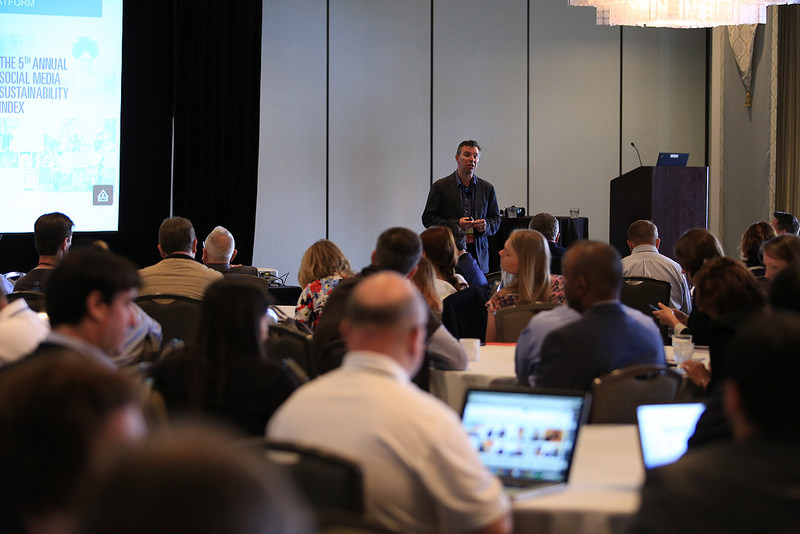Big Brands on Sustainability Platforms, Trends & Reach
Matthew Yeomans is the founder of Sustainly, a company that helps plan sustainability marketing and communication. Yeomans has over 20 years’ experience writing and editing at major publications, and 10 years’ experience advising companies in online communication strategy. He is the creator lead and author of the Social Media Sustainability Index.
Ten years ago, when Facebook was just a fledgling, the internet was the information superhighway and brands were fundamentally in control of their own information. Since that time, social media has brought about mass de-marketization: it has given consumers the power to communicate and publish their ideas and opinions about brands. This communications revolution shook the foundations of brand marketing, in that social media forced brands to be accountable in real time regarding people’s social media commentary. Given this change in information flows, companies today have no choice but to engage on social media.
Yeomans points out that both social media and sustainability are perfectly aligned to work together in a way that social media isn’t aligned with the traditional world of marketing. Social media is neither a tactic nor a strategy, because it has changed the way the world operates. Similarly, sustainability is neither a tactic nor a strategy, but rather a fundamental business necessity, because the companies succeeding in sustainability are the companies that are making it the priority business driver for the future.
Authentic Sustainability Brand Communications
In order to succeed in these arenas, brands must win over skeptical consumers with messages of authenticity and transparency, and they need to build community with their consumers in creative ways. These four characteristics, authenticity, transparency, community, and creativity, combine to form a very potent formula for successfully communicating sustainability via social media. Moreover, it should be noted that all social media channels are essentially just publishing tools, so in order for brands to succeed, they need to think like editors rather than thinking with old-school campaign mentalities.
There are three questions brands need to consider to be successful in communicating sustainability via social media:
- What does your audience care about?
- What do you have to say to meet their interests?
- How and where do they like to get their information?
While following this simple rubric may seem easy in principle, it often proves to be much more difficult in practice.
Lessons in Failed Social Media Sustainability Messaging
Unfortunately, many companies have proven that it is easy to make mistakes in the social media arena. Most commonly, brands tend to want to talk and forget to listen, and they fail to respect the power of the crowd. A primary example of this is when BP was told about the fake BP twitter account (full of sarcastic commentary from the public) live on CNN. Even though BP was spending millions at the time on Google AdWords and television campaigns, they weren’t paying attention to what people were saying. (They further worsened the situation when they attempted to shut the fake twitter account down.) Another example is when CelebBoutique.com mistakenly tweeted about the popularity of its Aurora dress after the tragic shootings in Aurora, Colorado.
Problems in social media marketing also occur when companies, feeling that they don’t have a handle on social media, either put younger staff in charge or outsource this responsibility. This was the case when HMV was in the process of reorganization: as HMV was spinning their down-sizing to the media, their employee responsible for Twitter was tweeting about the event. Another example is the Chevy Tahoe campaign, when the company asked the public to design decals for their SUVs and responses were taken over by a number of activist groups.
These failed attempts to use social media have left companies afraid to communicate sustainability on a brand level. While Facebook seems to be the social media choice of brands, a study of 195 brands belonging to the top fifteen consumer goods companies showed that only 74 were communicating about sustainability through Facebook, and four of those brands comprised 50 percent of that effort.
Crafting ‘Soft Sustainability’ Communications
Yeomans proposes that the best model to be followed is one of “soft sustainability.” Rather than hitting customers over the head with direct messages, communicating a brand’s image and efforts in softer ways can be much more effective. One notable example is the Lego Movie’s message of anti-capitalism and the need to be authentic and build trust.
In order to implement an effective soft sustainability strategy, Yeomans proposes that it boils down to the fundamentals of knowing your audience, your brand, and the temperature of the marketplace. In order to succeed with sustainability in social media, you must:
- Know your audience, know what they like to get, and know how to reach them.
- Know what you have to say.
- Know what you do well and be useful with it.
- Know your strengths and weaknesses.
- Know how to be transparent.
- Know how to be creative.
- Know how to be useful.
- Know how and when to lead.



